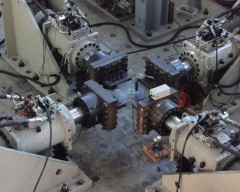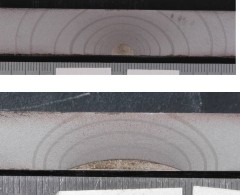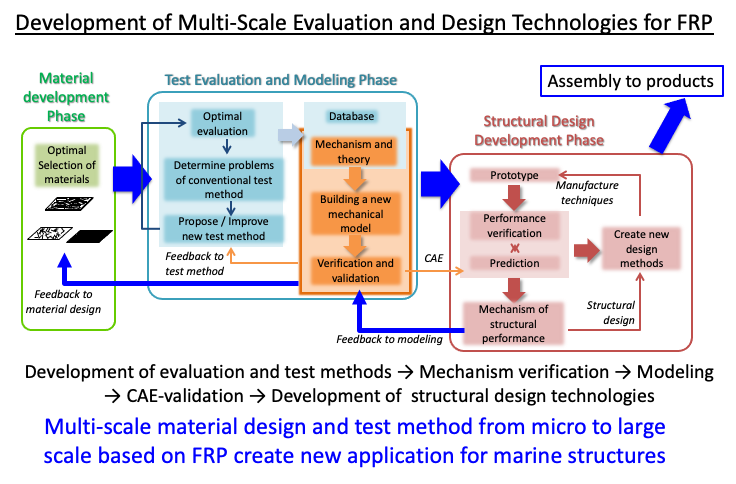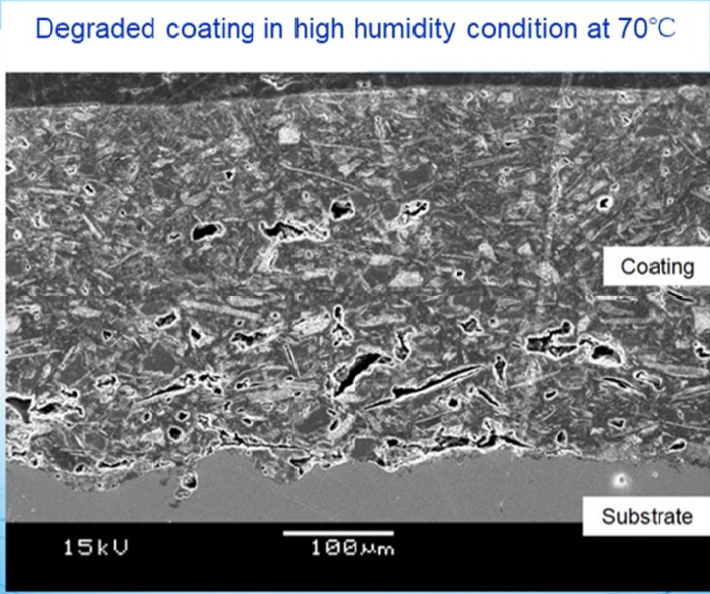Materials & Strength Research Group
MATERIALS & STRENGTH
To contribute to the realization of a safe and secure society and to enhance the competitiveness of the maritime industry, this group is engaged in a variety of research projects that will contribute to the advancement of structural and material evaluation and design technologies.
Members
(◎: Head of the Group)
Research
- Fatigue life estimation
- Evaluation of methods for improving fatigue strength
- Development of new joining technologies and new material technologies
- Clarification of the mechanism of protective coating degradation and study on the lifetime evaluation method
- International standardization of material and structural test methods
Overview of our research
1. Fatigue Life Estimation
There are many cases of damage related to fatigue damage of welded parts or stress concentration areas in large structures such as ships. For example, ships are subject to cyclic loading in a corrosive environment (typically seawater) during service. The behavior of fatigue crack propagation in such environments is essentially different from that in air. For developing an evaluation method for practical use in the fatigue strength design and maintenance planning of hulls, we have been working on the following topics.
- Clarification of Corrosion Fatigue Behavior
- Quantitative Estimation of Fatigue Surface Crack Propagation Behavior Caused by Surface Defects in Three-Dimensional Objects
- Quantitative Evaluation of Multiaxial Stress Effects on Fatigue Crack Propagation Behavior
- Clarification of the Effect of Dent Caused by Needle Peening on Fatigue Strength

Multiaxial Loading Fatigue Machine

Evaluation of Fatigue Damage Behavior
2. Evaluation of Methods for Improving Fatigue Strength
As hull structures have become huger, the plate thicknesses used have increased. On the other hand, it is generally known that the apparent (nominal stress standard) fatigue strength decreases (plate thickness effect) due to local stress concentration and increased tensile residual stress due to welding as the plate thickness increases. In recent years, the method of improving fatigue strength by smoothing out the shape while applying compressive stress has attracted attention. This group is working on the following topics to reflect the effect of improving fatigue strength by secondary processing, such as high-frequency mechanical shock processing, in the fatigue design guidelines.
- Determination of the effect of compressive stress
- Determination of the rate of increase in fatigue strength
- Determination of thickness effect index
- Clarification of cost-effectiveness
3. Development of New Joining Technologies and New Material Technologies
As one of the core technologies to enhance international competitiveness and promote the creation and development of related industries, R & D of optimal design, bonding, and adhesion technologies for multi-materials has been drawing attention. In recent years, the use of new materials has been expanding in other industries, as well as improving the strength of joints between dissimilar materials, and it is also necessary to promote the use of new materials in shipbuilding for general merchant ships. To utilize new materials that have not been used commonly for vessels due to the degree of freedom in design with high-performance materials and the efficiency of the construction process, this group is conducting research on improving the long-term reliability of adhesive bonding technology for dissimilar materials in consideration of aging deterioration by combining environmental deterioration acceleration test and various strength tests. Focusing on fiber-reinforced plastics (FRPs), which are lightweight and contribute to energy conservation, we are developing highly reliable design technologies based on multi-scale material test methods and numerical simulation techniques.

4. Clarification of the Mechanism of Protective Coating Degradation and Study on the Lifetime Evaluation Method
Thick anti-corrosion coatings protect ballast tanks in ships and offshore structures. We have evaluated the degradation process of such coating by EIS (Electrochemical Impedance Spectroscopy). Since it takes a long time for thick protective coating degradation to occur, accelerated test methods are also under investigation to carry out a lifetime evaluation in a short period.

5. International Standardization of Material and Structural Test Methods
Brittle fracture suddenly causes enormous damage and is difficult to predict. Therefore, it is one of the biggest concerns for people involved in ships, and it is necessary to accurately grasp the material strength (fracture toughness value) of the weld area, which is particularly prone to fracture. The shape of the test piece used in the experiment to determine the fracture toughness value is defined by the standard, and it is necessary to straighten the fatigue crack from the mechanical notch. However, the fatigue crack does not go straight on with the welded material as it is. However, it is known that by compressing (platen) the tip of the notch in advance, even if it is a welded material, the fatigue crack will go straight, and compressing (platen) is often done before having the fatigue crack. In the conventional platen method, the material is compressed directly at the point of fracture, which degrades the material and lowers the strength of the material. So, a heavy testing machine is required to compress ultra-thick pieces because of the increased load required. Therefore, this group is conducting research on the international standardization of a new platen method that allows fatigue cracks to go straight without directly pressing the fracture initiation point and can be carried out with the load capacity of a small testing machine. We are also working on international standardization of new joining technologies and new materials by proposing practical testing methods to contribute to the spread and expansion of their applications.
